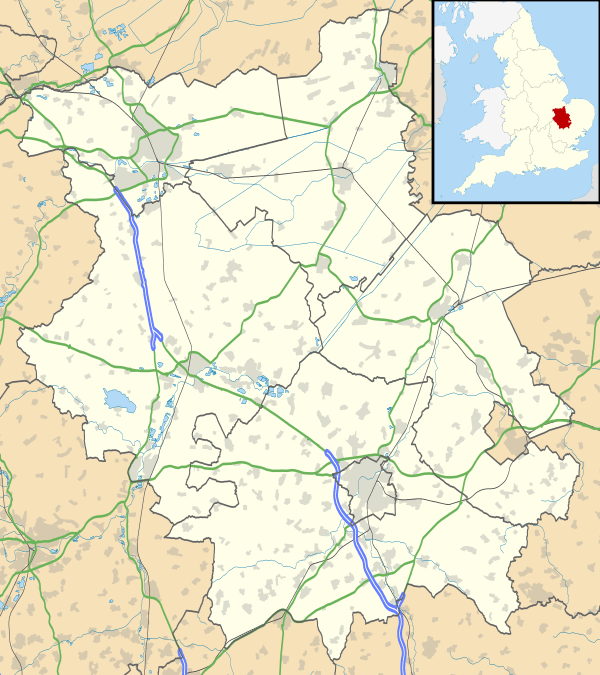Wimpole
| Wimpole | |
.jpg) |
|
 Wimpole |
|
| Population | 227 (2001) [1] 301 (2011)[2] |
|---|---|
| OS grid reference | TL337509 |
| Shire county | Cambridgeshire |
| Region | East |
| Country | England |
| Sovereign state | United Kingdom |
| Post town | Royston |
| Postcode district | SG8 |
| Dialling code | 01223 |
| EU Parliament | East of England |
| Website | http://www.wimpole.info/ |
|
|
Coordinates: 52°08′24″N 0°02′46″W / 52.14°N 0.046°W
Wimpole is a village and civil parish in South Cambridgeshire, England, about 8 1⁄2 miles (13.7 km) southwest of Cambridge. It is sometimes sub-divided into "Old Wimpole" and "New Wimpole". Notable people from Wimpole include the Independent minister John Conder. It is the site of the country house of Wimpole Hall and its accompanying Wimpole's Folly.
History
The village of Wimpole grew up just to the east of Ermine Street, in an area now occupied by the parkland of Wimpole Hall, and the southern boundary of the village is formed by the Roman road that linked Ermine Street to Cambridge. A Roman settlement has been found in the parish on the site of the south-west lodge near Arrington Bridge.[3]
Listed as Winepole in the Domesday Book, the parish formerly contained two other small settlements, Wratworth and Whitwell, but both had been absorbed into the single parish by the end of the 13th century, though the manor of Wratworth survived until the 17th century.[3]
The name "Wimpole" comes from "pool of a man named Wina". The pool in question is that found in Wimpole Park.[4]
The modern parish is 2468 acres in extent.
Parish church
Its parish church of St Andrew (still in use within the Orwell Group of Parishes, holding services on the first and third Sundays of each month) is next-door to the Hall and was once part of the Hall's estate (whose east service wing nearly abutted it at one point). It contains the family tombs of some of its residents, such as the Earls of Hardwicke, and a stained glass window commemorating Thomas Agar-Robartes, eldest son of Thomas Charles, 6th Viscount Clifton and Mary, Viscountess Clifton of Lanhydrock, Bodmin, Cornwall. A medieval church on the site was demolished (except for most of the Chicheley Chantry or Chapel dating to 1390, which survived despite thus being open to the north side of the body of the nave during the 1749 construction work) in 1749 to build the present nave and chancel.[3]
The chantry's name dates to when the estate was owned by Henry Chichele and his relations' descendents. However, it was actually founded by the previous owner of the estate, Sir William de Staundon (Master of the Grocer's Company, and Lord Mayor of the City of London in 1392 and 1407) in c.1390. He and his first wife Elizabeth are buried at Wimpole. Both the church and chantry were remodelled in Neo Gothic style in the mid 19th century, and then restored again straight after the Second World War, in 1993/4 and in 1997.
See also
References
- ↑ 2001 census
- ↑ "Civil Parish population 2011". Neighbourhood Statistics. Office for National Statistics. Retrieved 26 July 2016.
- 1 2 3 C. R. Elrington (ed) (1973). A History of the County of Cambridge and the Isle of Ely: Volume 5. Victoria County History. pp. 263–272.
- ↑ Walter Skeat (1901). The Placenames of Cambridgeshire.
External links
![]() Media related to Wimpole at Wikimedia Commons
Media related to Wimpole at Wikimedia Commons